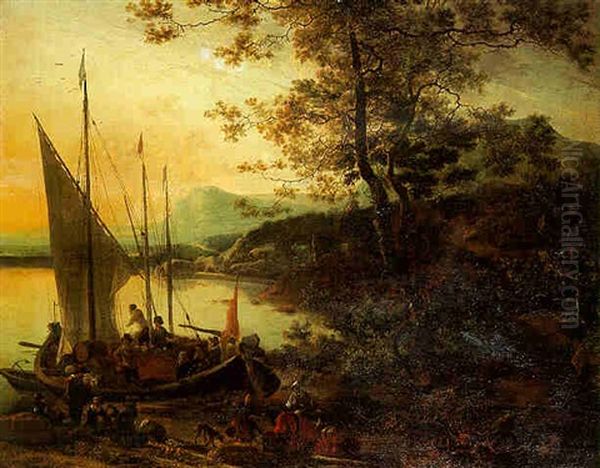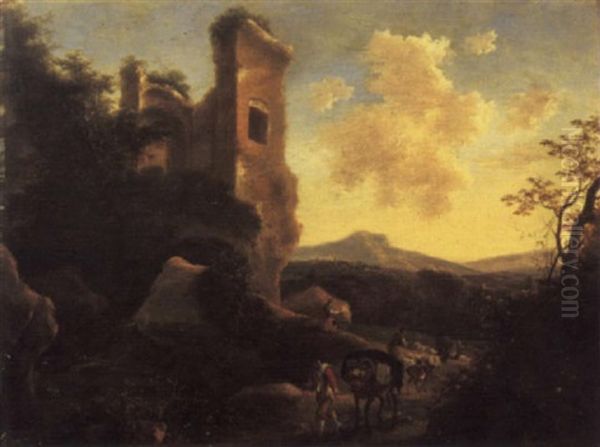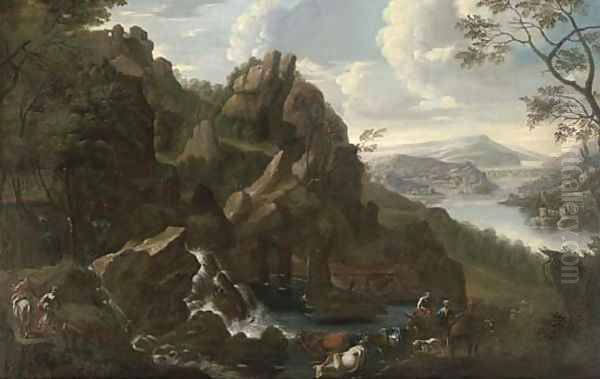Willem de Heusch stands as a significant figure among the Dutch Italianate painters of the 17th century. Active during the Dutch Golden Age, primarily in his native Utrecht, De Heusch (1625-1692) carved a niche for himself as a painter and engraver whose artistic vision was profoundly shaped by the landscapes and luminous atmosphere of Italy. His works, often characterized by idealized pastoral scenes bathed in a warm, golden light, contributed significantly to the popularity of Italianate landscape painting in the Netherlands and left a lasting legacy through his own art and the pupils he influenced.
Early Life and Artistic Formation in Utrecht
Born in Utrecht in 1625, Willem de Heusch entered the world during a period of immense artistic flourishing in the Dutch Republic. Utrecht itself was a vibrant artistic center, known particularly for the Utrecht Caravaggisti like Gerard van Honthorst and Hendrick ter Brugghen earlier in the century, and later for its strong tradition of landscape painting, especially the Italianate style. Detailed records of De Heusch's earliest training are scarce, a common issue for many artists of this period.
However, art historians widely concur that he likely received instruction from Jan Both (c. 1618/22–1652), another prominent Utrecht painter celebrated for his Italianate landscapes. The stylistic affinity between the works of De Heusch and Both is remarkably close, featuring similar compositional structures, treatment of light, and types of foliage. This resemblance is so pronounced that distinguishing between their unsigned works, or even identifying specific contributions in potential collaborations, remains a challenge for connoisseurs and scholars. Whether De Heusch was a formal apprentice or a younger colleague working closely alongside Both, the elder artist's influence was undeniably formative.
The Transformative Journey to Italy
Like many Northern European artists of his time, Willem de Heusch felt the magnetic pull of Italy. The allure of classical antiquity, the Renaissance masters, and, crucially for landscape painters, the unique quality of Mediterranean light and scenery drew artists southward. De Heusch undertook this formative journey, likely spending several years in Italy during the 1640s. Some sources suggest a stay between approximately 1640 and 1644 or 1645.

This period abroad was pivotal. Immersed in the Italian countryside, particularly the environs of Rome (the Campagna), De Heusch absorbed the visual language that would define his career. He experienced firsthand the warm, hazy sunlight, the picturesque ruins, the rolling hills, and the distinctive umbrella pines that became hallmarks of the Italianate style. This direct encounter with the Italian landscape provided him with a rich repertoire of motifs and atmospheric effects that he would draw upon for the rest of his life.
The Influence of Claude Lorrain and the Italianate Style
While in Italy, De Heusch undoubtedly encountered the works of contemporary painters active in Rome. The most significant influence appears to have been Claude Lorrain (born Claude Gellée, 1600-1682), a French painter who spent most of his career in Rome and became one of the most revered landscape artists in Europe. Claude perfected a style of idealized landscape painting, often depicting pastoral or mythological scenes set in the Roman Campagna, bathed in a soft, atmospheric, and often golden light, particularly at sunrise or sunset.
De Heusch’s works clearly echo Claude Lorrain's "Arcadian" vision – landscapes that evoke a sense of timeless peace and harmony, often populated by shepherds, travelers, and their flocks. It's plausible that De Heusch and Jan Both, who was also in Italy during the same period, studied and perhaps even copied Claude's works together. However, while deeply influenced by Claude, De Heusch developed his own nuances. Compared to Claude, who frequently incorporated biblical or mythological narratives into his grand compositions, De Heusch’s paintings tend to focus more purely on the idealized landscape itself, creating utopian visions of nature rather than specific historical or religious scenes. His figures often serve primarily to animate the scene and enhance the pastoral mood.
Mature Style: Capturing the Southern Light
Upon returning to Utrecht, Willem de Heusch established himself as a master of the Italianate landscape. His mature style is characterized by a consistent set of features. Foremost among these is his masterful handling of light. He excelled at capturing the warm, golden glow of the Italian sun, often depicting scenes at dawn or, more frequently, late afternoon and sunset. This suffused light unifies his compositions and creates a distinct, often tranquil or gently melancholic, atmosphere.

His compositions typically feature rolling hills, rocky outcrops, winding paths or streams leading the viewer's eye into the distance, and carefully rendered trees with feathery foliage. Ancient ruins – bridges, towers, or aqueducts – often appear, adding a touch of romantic nostalgia and referencing the classical past associated with Italy. Small figures, such as shepherds tending their flocks, travelers resting by the roadside, or peasants driving mules, populate these scenes. These figures, known as staffage, are integral to the pastoral ideal, enhancing the sense of scale and providing narrative interest without dominating the landscape. His palette favors warm earth tones, golden yellows, soft greens, and hazy blues for distant vistas. He often signed his works with the initials "G D Heusch," representing Guilliam (a variant of Willem) de Heusch.
Role in the Utrecht Guild and Artistic Community
Willem de Heusch became an active and respected member of the Utrecht artistic community. He joined the city's Guild of Saint Luke, the professional organization for painters and other craftsmen. His standing among his peers is evidenced by his election as dean (Vinder) of the Guild in 1649, a position he shared in managing with other artists, potentially including Jan Both and Cornelis van Poelenburgh (c. 1594–1667), another key figure in the Utrecht school known for his small-scale Italianate landscapes often featuring mythological or biblical figures.
His involvement in the Guild underscores his established position within the local art scene. Utrecht, during this period, was a hub for Italianate landscape painting, with artists like Both, Poelenburgh, Jan Baptist Weenix (1621–c. 1660/61), and later De Heusch himself and his nephew Jacob, forming a distinct school within Dutch art. They catered to a growing market of patrons who appreciated these idealized, sun-drenched views of the South, offering an escape from the flatter, cooler landscapes of the Netherlands.
Collaboration, Workshop, and Attribution Challenges
The close stylistic relationship between Willem de Heusch and Jan Both raises questions about their working methods. It is possible they maintained separate workshops but influenced each other heavily. Alternatively, they might have collaborated directly on certain canvases. Some art historians have proposed a division of labor in potential collaborations, where Both might have painted the primary landscape elements, with De Heusch adding the staffage figures. However, concrete evidence for such systematic collaboration is lacking, and the similarity in their figure painting styles further complicates attribution.
This stylistic proximity means that attributions have sometimes shifted between the two artists over the centuries. Works once given to Both have occasionally been reattributed to De Heusch, and vice versa. This ongoing scholarly debate highlights the deep artistic connection between them, whether rooted in a teacher-pupil relationship, close collegiality, or shared admiration for masters like Claude Lorrain.
De Heusch the Engraver

Beyond his significant output as a painter, Willem de Heusch was also an accomplished engraver and etcher. He produced a number of prints, primarily landscapes, that echo the themes and style of his paintings. At least twelve distinct etchings are known to be by his hand. These prints, often characterized by delicate linework and atmospheric effects, allowed his compositions to reach a wider audience.
His activity as a printmaker places him within a strong Dutch tradition of etching, famously exemplified by Rembrandt van Rijn (1606-1669), although De Heusch's landscape etchings are stylistically closer to those of Both or Italianate printmakers. This dual practice as painter and engraver demonstrates his versatility and commitment to exploring landscape themes across different media.
Representative Works and Their Characteristics
Several key works exemplify Willem de Heusch's artistic achievements. One of the most frequently cited is his Italian Landscape at Sunset (c. 1660), housed in the Rijksmuseum, Amsterdam. This painting encapsulates his signature style: a serene, expansive landscape bathed in the warm, golden light of the setting sun. A winding path draws the viewer into the scene, past shepherds with their animals and towards distant, hazy mountains, embodying the idealized, peaceful vision of Arcadia.
The Rijksmuseum also holds his Hermit among Ruins, showcasing his ability to integrate architectural elements and figures into a cohesive atmospheric landscape. Another interesting example of his work involves a recently rediscovered pairing: a red chalk preparatory drawing and the resulting oil painting, both depicting a wooded landscape with a shepherd driving goats along a path near rocky outcrops. This pairing offers valuable insight into his working process, moving from sketch to finished painting while retaining the essential composition and romantic mood. These works, along with others scattered in museums and collections worldwide, consistently display his dedication to the Italianate ideal.
Legacy and Influence: The Utrecht Italianates
Willem de Heusch played a significant role in sustaining the tradition of Italianate landscape painting in Utrecht into the later 17th century. His works were appreciated by collectors during his lifetime and continued to be sought after. His influence extended directly to the next generation through his nephew, Jacob de Heusch (1656-1701).
Jacob initially trained with his uncle Willem, absorbing the fundamentals of the Italianate style. He later traveled to Rome himself, further developing his skills before returning to Utrecht, where he enjoyed a successful career, sometimes working for prominent patrons. Jacob's style, while indebted to his uncle's, developed its own characteristics, often featuring slightly more dramatic compositions or cooler palettes, but the lineage is clear. Willem de Heusch's broader impact lies in his contribution to the rich tapestry of Dutch Golden Age landscape painting, representing the enduring appeal of the idealized Italian scene alongside other Dutch landscape traditions, such as the more naturalistic depictions of the Dutch countryside by artists like Jacob van Ruisdael (c. 1628–1682) or Meindert Hobbema (1638–1709), or the distinctive light effects in the works of Aelbert Cuyp (1620–1691).
Later Life, Rediscoveries, and Market Presence
Information about Willem de Heusch's later years suggests he may have faced financial difficulties. Records indicate that by the 1670s his economic situation might have declined, and upon his death in Utrecht in 1692, he was reportedly buried at the expense of the municipality. This contrasts with the apparent success suggested by his earlier role in the Guild and the continued appreciation of his works.
In recent times, interest in Willem de Heusch has been steady, if perhaps overshadowed by bigger names like Both or Claude Lorrain. His works continue to appear on the art market. For instance, an Italianate landscape sketch attributed to him was sold at Christie's in New York in 2010. Auction records from 2024 show landscapes attributed to him being offered with estimates ranging from €600-€800 and £300-£400, indicating a continued, albeit modest, market presence. The ongoing process of research sometimes leads to rediscoveries or reattributions, such as the aforementioned sketch-painting pair or works previously thought to be by Jan Both being correctly identified as De Heusch's.
Collections and Art Historical Standing
Willem de Heusch's paintings and prints are held in numerous public and private collections across Europe and North America. Key institutions housing his works include the Rijksmuseum in Amsterdam, the Louvre Museum in Paris, and major museums in The Hague and Rotterdam. Various regional museums and private collectors also possess examples of his art.
In the grand narrative of art history, Willem de Heusch is recognized as a skilled and important exponent of the Dutch Italianate landscape school. While perhaps not possessing the groundbreaking originality of Claude Lorrain or the dramatic flair of Salvator Rosa (1615-1673) – another Italian painter whose romantic landscapes were influential – De Heusch masterfully synthesized the influences he absorbed in Italy with his Dutch sensibilities. He created consistently appealing works characterized by technical proficiency, a sensitive handling of light and atmosphere, and a gentle, idyllic mood. He remains a key figure for understanding the breadth of landscape painting during the Dutch Golden Age and the enduring fascination Northern European artists had with the light and landscapes of the South. His contribution lies in his beautifully crafted visions of an idealized Italy, filtered through a distinctly Dutch artistic lens.